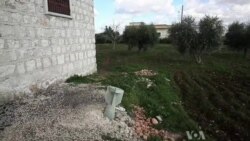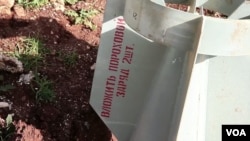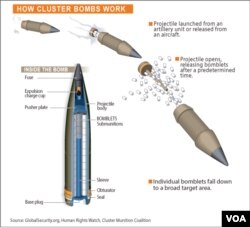AZAZ, SYRIA —
The Syrian government says it does not use cluster bombs against rebels or civilians. Human rights groups, however, say they have accumulated an array of evidence proving otherwise.
Russian markings on the remains indicate they were made more than 30 years ago. Each cluster bomb is specified to contain 30 smaller bombs — commonly referred to as submunitions or bomblets — that detach from the main bomb amid descent in order to inflict maximum damage. Local resident Mohamed Bakri described what happened.
“We were in our houses when we heard an airplane. Some people ran out into the fields and then the airplane dropped the bombs. We are farmers here. There there are no rebels or terrorists,” said Bakri.
Residents say only one of the large bombs detonated. Its bomblets landed in many places. Witnesses say one penetrated a house and seriously wounded Bakri's brother-in-law, a female cousin and three children.
The Syrian army said it does not possess cluster bombs, and Russia's foreign minister has said the Syrian government is not using cluster munitions from Russia.
VOA showed photos of the bomb parts to several weapons experts. Chris Harmer, with the Institute for the Study of War, said they are not cluster weapons.
"This looks to me like an 81 millimeter mortar, or possibly a 120-millimeter mortar. This is clearly not a cluster munition," said Harmer.
Several other analysts contacted by VOA, however, strongly disagree.
An expert with the Washington-based Global Security group, Joseph Trevithick, said the photos show a type of cluster bomb designed to destroy armored vehicles, such as tanks, not people.
“It suggests that the government is either trying to instill fear in the local population or [it] fears the local population has been infiltrated by anti-government elements and is using the means it feels it has available to attack them,” he said.
Human rights groups say the Syrian military since October regularly has been using cluster bombs on civilians in rebel-controlled areas.
Donatella Rovero is documenting cluster bomb attacks for Amnesty International. She said cluster bombs have killed or wounded tens of thousands of civilians, and have virtually emptied villages and towns in rebel-held areas.
“Yes. Quite clearly the use of indiscriminate weapons on non-military targets and certainly on the scale as we've seen in Syria, there is no doubt that this constitutes war crimes,” said Rovero.
U.N. officials are urging the International Criminal Court to investigate senior Syrian officials for possible war crimes and crimes against humanity.
Azaz has been bombed repeatedly by Syrian government forces since the rebels seized it eight months ago. Once home to 55,000 people, it is now a ghost town: 90 percent of the residents have fled.
In late January, residents of Azaz say Syrian government forces dropped nine large cluster bombs, what arms experts say is a particularly deadly weapon, on a neighborhood near the outskirts of town.
“We were in our houses when we heard an airplane. Some people ran out into the fields and then the airplane dropped the bombs. We are farmers here. There there are no rebels or terrorists,” said Bakri.
Residents say only one of the large bombs detonated. Its bomblets landed in many places. Witnesses say one penetrated a house and seriously wounded Bakri's brother-in-law, a female cousin and three children.
The Syrian army said it does not possess cluster bombs, and Russia's foreign minister has said the Syrian government is not using cluster munitions from Russia.
VOA showed photos of the bomb parts to several weapons experts. Chris Harmer, with the Institute for the Study of War, said they are not cluster weapons.
"This looks to me like an 81 millimeter mortar, or possibly a 120-millimeter mortar. This is clearly not a cluster munition," said Harmer.
Several other analysts contacted by VOA, however, strongly disagree.
An expert with the Washington-based Global Security group, Joseph Trevithick, said the photos show a type of cluster bomb designed to destroy armored vehicles, such as tanks, not people.
“It suggests that the government is either trying to instill fear in the local population or [it] fears the local population has been infiltrated by anti-government elements and is using the means it feels it has available to attack them,” he said.
Cluster Munitions Factbox
Cluster Munitions Factbox:- Weapon containing many explosive submunitions or bomblets
- Dropped from aircraft or fired from the ground
- Weapon breaks open in the air, scattering submunitions across a broad area
- Many submunitions fail to explode on impact, putting people at risk for years
- Several countries have used cluster bombs, including the United States
- The U.S. says cluster munitions have demonstrated military utility, and can often result in less collateral damage than a larger bomb or artillery shell
Donatella Rovero is documenting cluster bomb attacks for Amnesty International. She said cluster bombs have killed or wounded tens of thousands of civilians, and have virtually emptied villages and towns in rebel-held areas.
“Yes. Quite clearly the use of indiscriminate weapons on non-military targets and certainly on the scale as we've seen in Syria, there is no doubt that this constitutes war crimes,” said Rovero.
U.N. officials are urging the International Criminal Court to investigate senior Syrian officials for possible war crimes and crimes against humanity.
Azaz has been bombed repeatedly by Syrian government forces since the rebels seized it eight months ago. Once home to 55,000 people, it is now a ghost town: 90 percent of the residents have fled.













